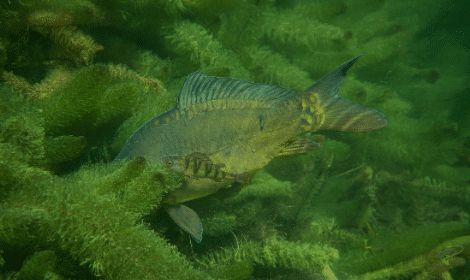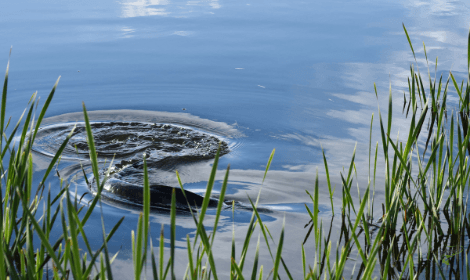
I know many anglers who avoid fishing around submergent or emergent aquatic vegetation, not just for carp but for any species.
I can completely understand why, who wants to spend hours of their limited time fishing dealing with snags and retying rigs?
Carp fishing in weed can be pretty productive if done correctly, many anglers don’t take the time or have the patience to fish in these places, leaving out opportunities to catch some great fish.
In this article we will look at some tactics to employ for fishing carp in the aquatic jungles that many anglers tend to stay away from.
Why Fish Weeds?

I’m sure you’re probably wondering why you would take the risks of snags and tangles in weeds when you can just fish a clear part of water.
Well I suppose you could but believe it or not carp absolutely love spending time in weeds.
Instead of waiting for a fish to pass by your bait in open waters why not take your bait to them and massively increase your chances.
Weed contains a plethora of natural foods for the carp such as snails, crustaceans, larvae and various insect nymphs.
They also feel protected and secure in the cover of weeds so they can be more inclined to feed.
During the day, weeds will also dissolves plenty of oxygen into the surrounding waters so carp tend to not swim too far if oxygen levels in the water are a little low.
Another benefit of fishing weedy waters is that a lot of anglers tend to avoid them when the weeds rise.
Unexperienced anglers lack the skill and knowledge to tackle weedy waters so tend to avoid them.
What does that mean for the people willing to fish them? Well for a start the fish will be under far less angling pressure which should make them less wise to common carp baits and presentations.
A quiet water also gives you the opportunity to fish more of the water and also the opportunity to move pegs freely if things aren’t going to plan.
As weedy lakes tend to be richer in oxygen and natural food sources for the carp the fish can often grow larger than in non-weedy waters.
I’m sure you can now see why fishing for carp in weeds can be well worth the risk of a few tangles and snags.
Keep reading to find out how to approach this type of fishing.
Learn the Weed Beds before you Fish
We recommend you learn the weeds in the area you intend to fish before rigging up. I like to take a weight and a bare hook, cast into the weeds, and try to bring some weeds back to the bank with me.
Doing this allows you to see the average length of the weeds in the area, and then you can plan your rigging accordingly so the bait sits above the weeds instead of in them, where they become hidden and obscured.
Also take note of how hard it is to pull your weight through the weed bed to try to determine how dense the weed bed is, the thicker the weed bed is the more you will want to use pop up rigs to fish it.
If you cast into areas of thick weeds with normal bottom baits you risk your bait becoming submerged and covered in weeds which the carp will have a hard time finding.
If the weeds beds are sparse with plenty of room between stalks, you can get away with other rigs that present your bait closer to the bottom.
Another great thing about studying the weed beds in the manner described above, is that you can actually figure out where the weed line is, or where it transitions to bare bottom.
The outside edge of these weed lines make a natural travel corridor or run for large fish like carp, and in many cases is the best location to place your bait presentations, but your casting and spodding needs to be pretty precise to fish the edge.
Baiting in Weeds
When fishing thick weeds we would recommend using small PVA bags with light particles.
This tactic allows the smaller particles to actually rest on the weeds higher up in the water and attract cruising carp to that specific area.
Now contrary to what some carp anglers will tell you, you can also use PVA baiting on the bottom with a pop up above it in the weeds.
While fishing pop ups above bottom bait might be detrimental in clean bottom areas, you can do this and be successful in weeds, with many carp not holding tight to the bottom and cruising higher up closer to the surface in denser weed beds.
Carp Rigs for Weed Fishing
Braid and Fluorocarbon lines are great lines to use for rigging. Braid is supple, allowing your bait to sit naturally among the varying vegetation, and fluoro while being stiffer, is nearly invisible in the water, giving a very stealthy and natural bait presentation.
When it comes to hook link length it depends on a few factors, such as weed density and height.
If the weeds are taller and dense, pop up rigs with a hook link that are a little taller than the weeds is your best bet, allowing cruising carp just above the weeds to see and eat your bait.
If the weeds have pockets or clearings among it, you can fish these with shorter hook links, as fish tend to hang out and cruise through pockets and lanes a little deeper since there are no obstacles.
Don’t be afraid to experiment with different rigging lengths and types, and if you’re not catching fish do so every few hours to find what works. If the fish are there you should be getting action fairly quickly in the weed beds.
Safety Rigs
Many times when you hook a carp on your pop up boilies or other presentations in the weeds, the carp will try to dive into the weeds, this can cause issues and result in your line breaking.
If the line breaks, you have a fish with a hook, line and weight snagging on all the weeds and causing the fish to become stuck.
As catch and release anglers, this is detrimental to the fishes well being. To avoid this from happening we recommend having a rig with safety lead clips.
These will detach the lead weight from the line, in the event the fish takes you on a journey through the weed bed, you don’t have that lead weight snagging up and causing issues.
If the line does break on you, the fish will have much greater chance of being able to navigate the weeds freely with only a pierced lip and some jewelry until the hook rusts out.
Tackle Considerations
A stout Rod
Using a spod rod for fishing carp might be your best bet in heavy weed growth. The heavy rod will give you plenty of backbone when it comes to hauling big carp out of weeds, especially if that carp and your line are tangled in it.
A Big Pit Reel
A big pit reel loaded with braid is not a recommendation, it’s essential.
Not only does it give you great sensitivity, the braid is actually good at slicing through weeds under tension and force, like when fighting a fish.
It’s also going to handle the strain of this type of fishing. I would also recommend you use 20 pound fluorocarbon for your shock leaders, while this means less stretch, it’s stronger than monofilament, but ultimately the mono/fluoro choice is yours.
Weed Type Considerations

Silkweed
Silkweed is a good weed type to target as it tends to hug the bottom and is full of natural forage for carp.
With silkweed your bait does not need to be high off the bottom, and lighter bait types for spodding allows your freebies to lay on top of the silkweed.
You can run pop up style rigs with boilies or other baits much closer to the actual bottom with the lower lying weeds.
Canadian Pondweed
Canadian Pondweed grows much more dense and higher than silkweed does, this will require you to change up your rigging if you are fishing in this weed type by using longer hook links with pop ups to get above the weeds slightly.
We recommend you find weed beds of this type of weed that aren’t to the surface and choking out the area, making it essentially impenetrable to you or fish. Any pockets or lanes in the weeds will also be a great place to place bait and fish.
Milfoil
Milfoil can grow incredibly dense and thick in some areas, making it essentially unfishable. But that doesn’t mean you shouldn’t fish near it.
Milfoil has a tendency to grow in large clumps with space in between clumps if they are spread out, making it a great place for carp to cruise in and provide them cover.
Other milfoil beds may completely choke out an entire area of shallow water and then stop with a well defined wall of vegetation, this prominent edge can provide a great natural travel area for carp, and you should be fishing this edge.
Eelgrass
Eelgrass is the weed that, well, looks like really long grass. It grows very quickly and as spring progresses into summer it can completely dominate an area, and the best part about eelgrass? The carp LOVE it.
Snails and other forage love to hang out in eelgrass, prime forage for carp, and at certain times in bare areas directly adjacent to eelgrass, the carp might be having a feast or snails and snail eggs.
If you snag and retrieve eelgrass, it might even smell like a carp due to their tendency to hang out in the stuff.
Fighting Weed Carp

If you’re fighting a carp in dense weeds and it tries burying itself in it or gets caught up my first trick is to maintain tight pressure on the line.
Many times when this happens and I apply pressure, the carp will kick and work in your favour to free itself from the jungle.
If the pressure method fails, try slacking up your line, and set your drag looser.
The fish will probably over time swim out of the weeds that it buried itself in. If the line tightens again it means the fish has started moving again and you should commence the fight.
If the hooked fish continues to sit tight in the weeds then another option is to take the fight to the water.
Some venues offer small boats which can be a great tool for fighting stubborn carp in weedy waters.
If the fish becomes lodged in dense weed, jump in the boat and paddle out to the fish to put pressure on the fish from a different angle.
Sometimes this is enough to free the fish, if not you can paddle above the fish and use your oar to try and dislodge the fish.
Conclusion
Bottom line is, don’t let fishing for carp in weedy areas intimidate or deter you.
It sounds weird, but I know many anglers who avoid weeds like the plague, while I have personally learned to embrace it and it has proven to pay off many times, in particular on bodies of water where it’s heavy in weeds throughout and often I have the entire area to myself with carp surfacing everywhere.
Just take into consideration the tactics in this article as well as the type of weed you’re fishing, to give yourself the most optimum presentation possible.


Liked your article,very informative,You MUST be British.
Hi Dave, glad you found the article helpful.